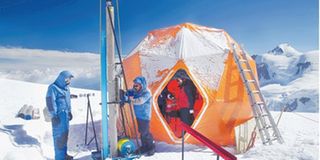Ice Memory: An ambitious international scientific project on the heights of Kilimanjaro

What you need to know:
The largest mass of ice still available lies on the Northern icefield of Kilimanjaro, at 5800m altitude. With a surface of 0,5km² it could preserve, frozen in its midst, a unique and last archive of 11700 years of climate and environmental history. Recent studies have shown in 2015 that the maximum thickness of this glacier is still 53m
The highest peak in Africa is well known for its eternal snow and glaciers. Unfortunately, they are now at risk because of global warming. Scientific observations have been documenting this glacial erosion for several decades and have announced the inescapable disappearance of the last great glacier of Africa within the next decades.
The largest mass of ice still available lies on the Northern icefield of Kilimanjaro, at 5800m altitude. With a surface of 0,5km² it could preserve, frozen in its midst, a unique and last archive of 11700 years of climate and environmental history. Recent studies have shown in 2015 that the maximum thickness of this glacier is still 53m. These measures give hope that a good part of the environmental archive is still available, but for how much longer?
The Ice Memory project is an international scientific initiative launched in 2015 to save the glacial heritage around the world. UNESCO commended the project during its 205th executive board in 2018 and highlighted the importance and the urgency of preservation of the glacial archives of the African continent, kept in the ice cores of Kilimanjaro. It is why after the Mont Blanc in France in 2016, the Illimani in Bolivia in 2017, the Elbrus and the Belukha in Russia in 2018, the Kilimanjaro will be in September 2019 the next destination of the Ice Memory expedition. The international scientific team will be headed by the French National Research Institute for Development (IRD) associated with scientific teams from Tanzania, France, Italy, Switzerland, United States and Russia.
As for the highest glaciers on the planet, the Kilimanjaro icefield is only accessible on foot and all equipment and ice will be moved with the help of experienced Tanzanian guides and porters. Three camps will be installed between 3700m and 5800m, and ice cores will be stored in a refrigerated container before shipment. The expedition expects to extract 4 to 6 ice cores of about 53m depth each to transport them to the Institute of Environmental Geosciences (IGE) in France.
One of the ice cores is already dedicated to scientific observations and will allow to get thanks to the new technology a maximum of information. The other ice cores will be preserved in the French Paul-Emile Victor Polar Institute in Antarctica as archives for the next centuries. It will be at the disposal of scientists of future generations after the original glacier has disappeared.
Tanzanian students and researchers (Master and PhD levels) will be associated to this great scientific adventure and gain from this an international experience. French Embassy will bring its support by offering scholarships to the Tanzanian universities involved in this ambitious international project.
On that basis thereof, Tanzania’s involvement in this groundbreaking global research is expected to benefit the country in a sublime manner as confirmed by Prof. Patrick VALIMBA, from Department of Water Resources Engineering, College of Engineering and Technology, University of Dar es Salaam (UDSM) through an interview held with the Citizen.
Why is the ice Memory project important for Tanzania?
Tanzania has remains of the large tropical glacier in Mount Kilimanjaro. However, the glacier has significantly decreased to a small cap on the mountain, raising several hypotheses. A few studies on climate and hydrology in northeast Tanzania tried to investigate water resources variations in relation to historical evolution of climate around Mount Kilimanjaro.
To date, limited knowledge exists on the real cause of the glacier decline and its associated impacts on the water cycle and community livelihoods from Kilimanjaro Region to as far as the coastal areas of Tanga Region along the Indian Ocean shoreline. Whilst searching for understanding of the glacier melting and the regional climate evolution, the glacier itself is diminishing at alarming rate to the extent that some predict its complete disappearance in the nearest future. Consequently, Ice memory project is vital for Tanzania as it will provide samples of the Kilimanjaro glacier for future analyses to uncover some of the current missing knowledge.
What are the expected outcomes of the Ice Memory project for the country?
The major expected outcome of this project is to have Kilimanjaro glacier cores stored in archives, which can be accessible to everyone (including Tanzanians) needing to utilize them to advance knowledge. Moreover, any knowledge that is going to be derived from the cores will be communicated to relevant authorities in Tanzania so that informed decisions can be reached


